7 Employee Engagement Activities for Remote Teams
Have you ever heard of the “Social distance” concept?
No, it’s not what you’re thinking. I’m not referring to social distancing, the recommended physical distance as part of COVID-19 guidelines.
The Social distance in question here is a concept in psychology. It is also called “Psychological distance".
What does it mean?
The APA Dictionary of Psychology defines social distance as:
The degree to which, psychologically speaking, a person or group wants to remain separate from members of different social groups.
In other words, social distance is when people get detached and disengaged from each other psychologically.
Why the psychology lessons today?
Well, as you are aware, a lot of companies are now either fully remote or remote-first hybrid. That’s all well and good, but what about the impact of remote working on employees?
You’ve got it: Social/Psychological distance happens.
The truth is your remote employees are probably suffering from the social distance problem. As the manager, I bet you’re practically seeing it happen: At Friday’s meeting, you realize the last time your team communicated with each other was at the previous meeting. Or, when you notice employees are unaware of what is going on in each other’s lives.
Little by little, they get disconnected from each other due to the problem of social distance. Professor Tsedal Neeley, a teacher of teamwork at Harvard Business School, said:
Social distance denotes a lack of connection between co-workers or colleagues.
This lack of emotional connection between remote employees festers and leads to employee disengagement. However, this isn’t likely to happen in an in-office setting. Employees are more emotionally connected to each other because the lack of a physical barrier means they see each other all the time and have meaningful conversations.
On the other hand, it’s often out of sight, out of mind among remote employees:
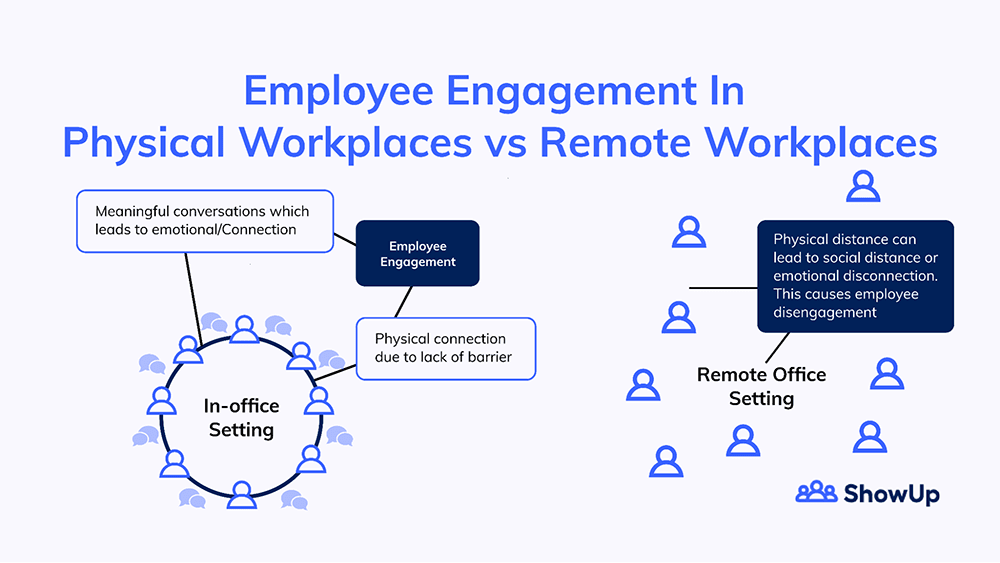
Therefore, deliberate efforts have to be made to foster and improve engagement among your remote team.
Rachel Jay, Senior Career Writer at FlexJobs agrees:
Keeping remote workers engaged is a necessary part of leading a remote team, company or employee. Without the ability to have organic conversations in the break room or at each other's cubicles, it takes a more concentrated effort for remote workers to engage with others … A lack of engagement can lead to isolation and loneliness, a lack of passion for the company's vision or goals, and feeling unhappy and unappreciated.
Due to the social distance concept, employee engagement is even more essential for remote work to truly thrive. Like Caroline Castrillon, Founder, Ceo, Career, and Life Coach, wrote:
Remote work requires more engagement.
It is the duty of none other than you, the manager, to exert more effort in engaging remote employees with some employee engagement strategies and activities.
Fortunately, that’s what this piece covers: remote employee engagement activities. You’ll discover some pretty fun and cool engagement activities you can play with your remote team. You’ll also learn how ShowUp, a team pulse tool assists managers in engaging their employees.
Measure the engagement of your remote team with ShowUp
You can also navigate this piece with the table of contents below.
Table of Contents:
Employee engagement activities for remote teams
What really is the appeal of remote working?
For employees, it is the freedom to work when and where they want. The majority of the working population want flexibility and control of their work schedule, which working from home grants them. A 2019 Buffer State of remote work-study revealed 40% of respondents consider a flexible schedule to be the biggest benefit of remote work.
So, the remote trend is not a fad and isn’t going away in the near future.
As a forward-thinking manager, you must be proactive and come up with creative activities to boost engagement in your remote staff. Here are 7 fun, but effective virtual employee engagement activities to get you started.
Motivation Monday
As you have that Monday stand-up or meeting with your employees, make it a point of duty to intrinsically motivate them. Doing this can ignite a spark and instill the workplace passion they should feel towards their job.
Why?
Engaged employees have been found to be intrinsically motivated. Brad Richardson, VC & Former Operations Vice President of Paycom brilliantly put it in this piece:
Intrinsic motivation is an important ingredient in the stew of employee engagement, and employee engagement is critical to competitive success.
You can motivate them by sharing some powerful words of motivation in your Monday meetings. Also, once in a while, you can bring in an external motivational speaker for Motivation Monday.
This activity, when done well, is great for engaging your remote workforce.
Casual Fridays
In contrast to your Monday meetings, Friday meetings shouldn’t be formal at all. Instead, it should be more of an informal and casual affair.
The more work-related discussions you can avoid, the better. A rule of thumb is to request personal updates and developments from employees. No work-related developments.
What is the result of Casual Friday?
This practice will help rekindle the emotional and personal connection between employees. Thereby, curbing the problem of social/psychological distance that often causes disengagement among remote employees.
Gamification
Filza Naveed, Content Marketing Manager, defined Gamification as:
The process of using game-based elements such as scoring, rewards or competition in workplace settings to get people to become actively engaged with their work.
From Filza’s definition, it is easy to see why the Gamification trend is widely catching fire among managers and HR professionals. This is because it uses psychology to engage, motivate, and educate employees.
Let’s look at how Telus, a telecommunications company, used gamification to improve its employee engagement.
The company, under its Chief Envisioner’s management, Dan Pontefract wanted to work on its engagement score of 54%.
Dan introduced two types of video games to help: The first is a video game that helps teach empathy to employees, while the second game puts employees in the shoes of workers that interact directly with customers.
The result of his gamification efforts was incredible. From its previous engagement score of 54%, Telus jumped to a new employee engagement score of 87% in just 6 years.
That’s the impact of gamification on employee engagement.
For your remote team, there are numerous gamification software you can use to boost employee engagement and retention. Examples include Bunchball Nitro (the very first gamification platform), Mambo.io, Hoopla, etc.
Gift/care boxes
Sending over a carefully curated gift box to your virtual team members is a great way to show you care about them. These boxes don’t necessarily have to be expensive. It could contain little things like candy or thoughtful items like a coffee coaster.
Irrespective of the content of your gift box, it is still an effective way to engage remote employees. Benish Shah, Chief Growth Officer at Loop & Tie said this about gifting employees post-pandemic:
The pandemic has made people feel disconnected, so a reminder that they are not out of mind simply because they are out of sight goes a long way. When employees feel appreciated, they remember that feeling well beyond this moment.
That feeling fosters connection and loyalty, which results in employee engagement. In fact, in this article by Snacks with bite, a snacks delivery service called care boxes:
Online bingo
Virtual or online bingo is a fun and lighthearted game that you and your team can play on casual Fridays. The aim is to engage employees by getting them to admit funny and slightly embarrassing things they do while working from home.
How to play?
You’ll need a bingo board that contains the activities which team members will strike through if they are guilty of or not. You can download, or create such a board by yourself.
For inspiration, here’s a visual example of a bingo board game for remote teams:
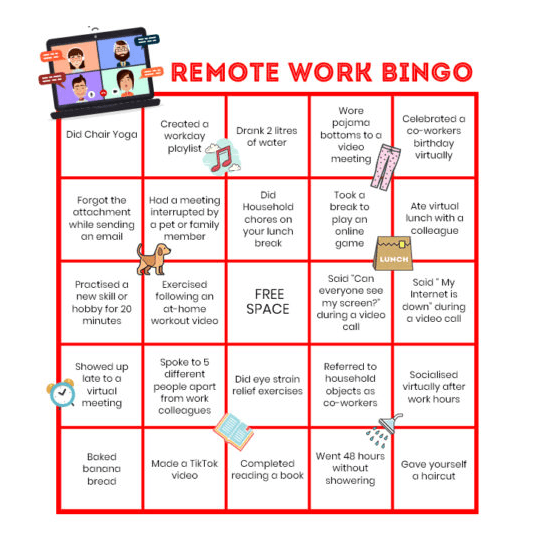
Charades
Remember those games of charades you played when growing up?
Well, it can be played virtually now, and it does a great job in terms of employee engagement. To play, you will need two things: a charades idea generator like this one, and at least two teams.
After grouping employees into teams, have someone from each team randomly pick a word or phrase from your charades idea generator and act it out. The rest of the team has to figure out the correct phrase being mimicked before the time elapses.
The better the acting skills and teamwork spirit of a team, the higher their chances of winning.
Of course, the team with the most points wins. However, the manager or moderator has to be on the lookout to ensure that the charades idea generation is truly random and not deliberately picked.
Charades is another fun activity with the added benefit of engaging your employees because it increases teamwork and trust among employees.
Measure real-time employee’s engagement
The final employee engagement activity on this list is measuring employees’ engagement levels in real-time. It’s one of the most effective ways to achieve real engagement results in your remote team.
William Craig Founder and President of WebFX said:
Measuring employment engagement in real-time helps companies achieve real results, just as the importance of measuring finances and sales regularly do.
How do you measure employee engagement in real-time?
By using a team pulse tool like ShowUp to survey employees and real-time insights:
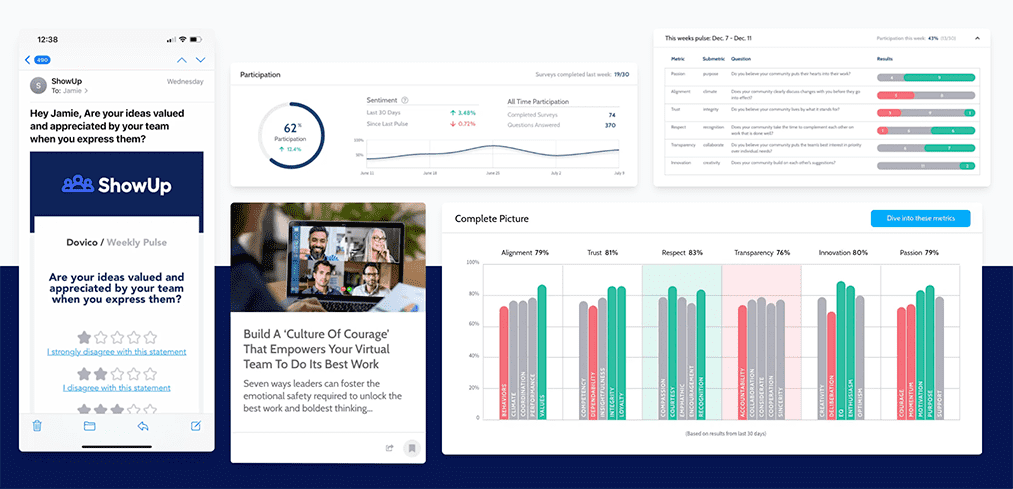
Measure employee engagement in real time
With ShowUp’s Automated Team Pulse Survey Software.
I’ll show you more on how ShowUp helps managers monitor employee engagement levels of their employees in real-time. But first, let’s look at what the drivers of remote employee engagement are, and why you should monitor them.
Employee Engagement, a constant work in progress
The drivers of employee engagement are basically employee traits that impact their engagement in an organization. ShowUp, after much research, and peer review, has identified 6 such drivers.
They include:
- Alignment
- Passion
- Transparency
- Trust
- Innovation
- Respect
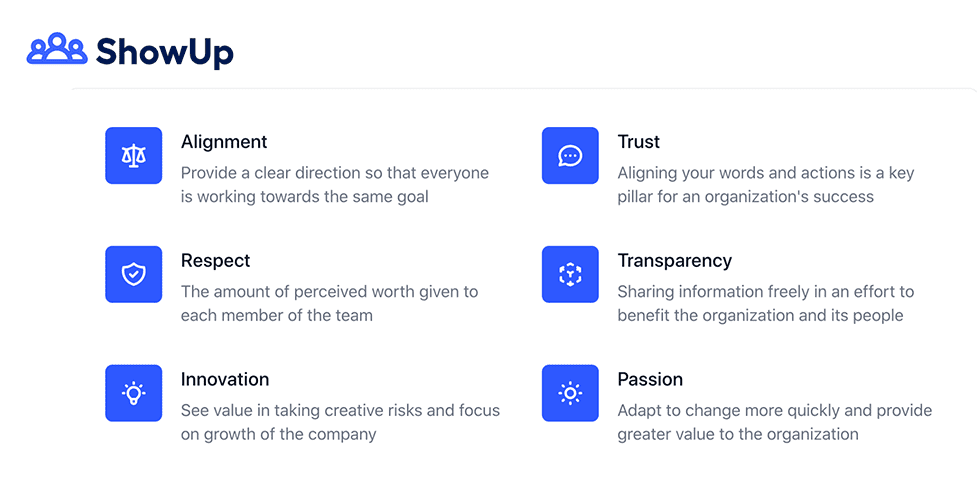
This means that the above traits are what actually influence employee engagement in your remote organization. Does that make sense?
Good.
Now, let’s look at…
Why you should monitor the driver of engagement in employees
Failure to monitor the engagement levels in employees is like neglecting your regular medical checkups...both can prove quite detrimental.
For a remote company, more attention has to be paid to the drivers of employee engagement because of fear of the aforementioned social/psychological distance, and other factors.
Caroline Walsh, Vice President, Gartner said,
During disruption, it’s especially important to make sure employees don’t become disengaged or frustrated as they adjust, for instance, to a new remote work environment or new business priorities. But there are still clearly identifiable drivers of employee engagement and performance that you need to watch.
Regular observation of these drivers, especially in real-time, leads to better-engaged employees. As mentioned earlier, ShowUp helps managers monitor engagement levels in real-time.
It’s high time I show you how ShowUp does that.
ShowUp, the managers’ tool for keeping in touch with employees and monitoring employee engagement.
ShowUp makes use of pulse surveys to keep track of employees’ pulses in real-time. The great thing about ShowUp’s pulse surveys is that it doesn’t disrupt employees schedules at all.
It is easy, and fast to fill.
This makes it a great option for managers that want to monitor busy employees’ engagement.
Sheila Heen, a Harvard Law School lecturer and Co-founder of Triad Consulting Group, said:
People think that this whole ‘feedback thing’ has to take a whole lot of time, when in the best working relationships, where people really do learn and grow and support each other, feedback is just woven into their workflow a few minutes at a time
The way ShowUp’s surveys are sent is similar to Sheila’s advice. The surveys are automatically sent to your employees’ email inbox:
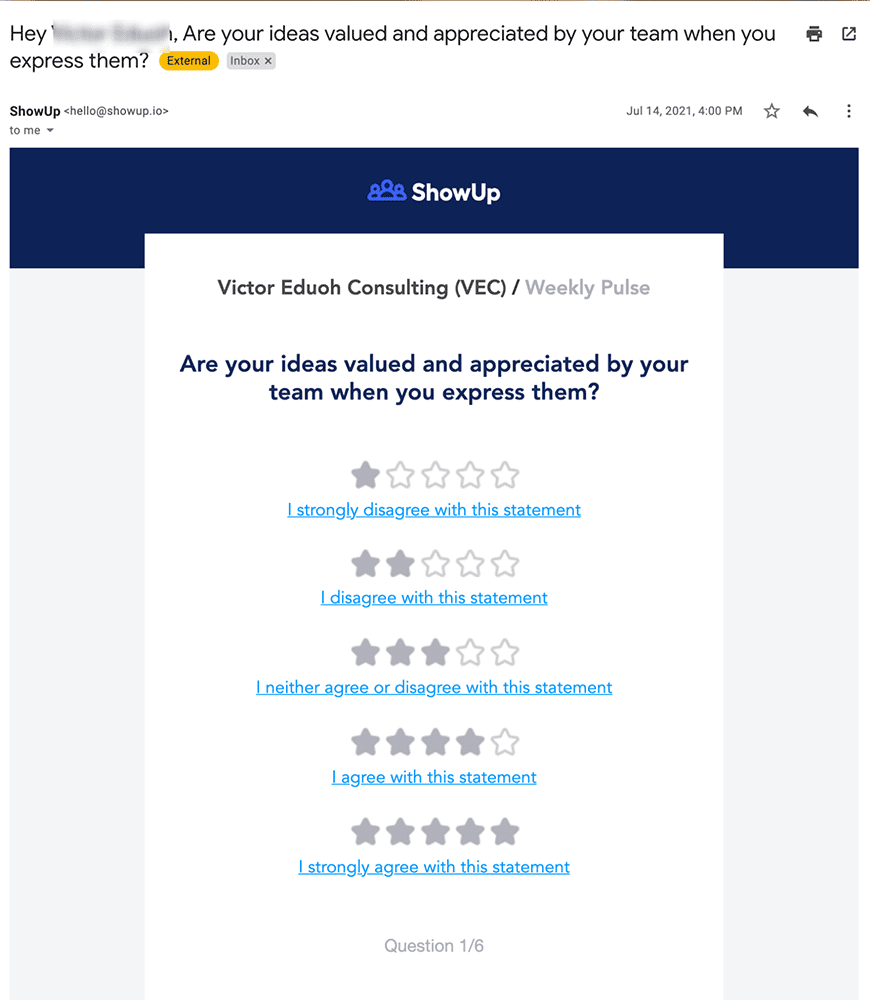
Then, to make for an easier response, it seamlessly transitions into a webpage with all the other survey questions.
Like this:
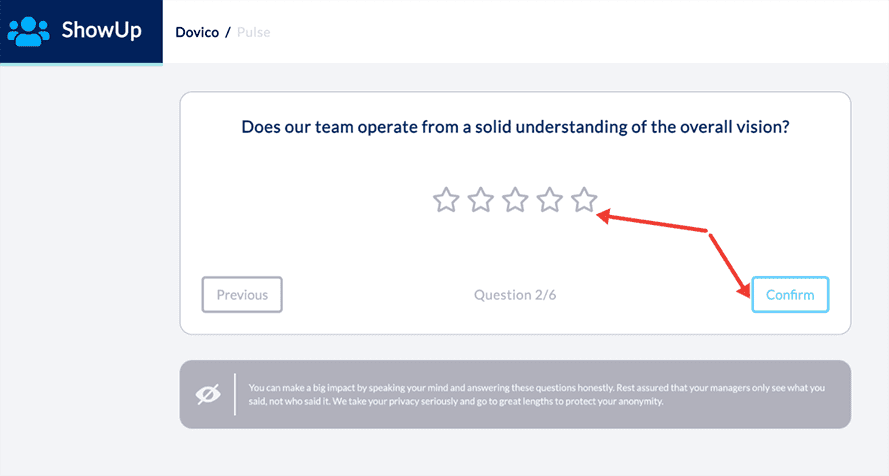
The whole process is smooth and is woven into your employees’ workflow. It takes only 2-3 minutes to complete a ShowUp survey!
After completing ShowUp’s pulse survey, what next?
ShowUp then crunches the survey results for better data assimilation:
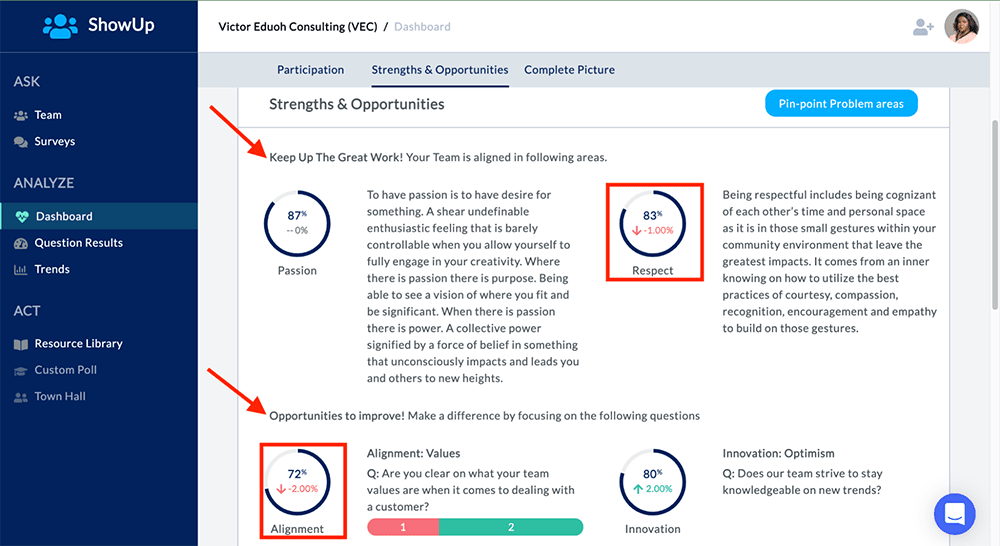
To help you act because like Jacob Shriar, Growth marketing manager said:
Just like any other survey though, remember, if you’re not ready to act, then don’t bother,
ShowUp also recommends resources:
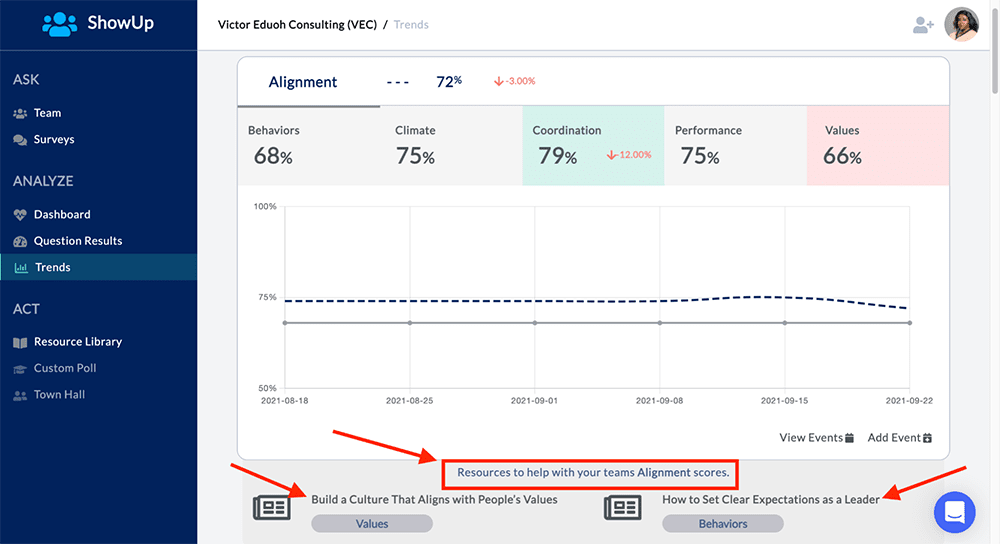
Brainstorm more employee engagement activities by asking your team
The engagement activities listed above are merely to get you started.
More can (and should) be done. I encourage you to brainstorm more activities with your remote team members. Ask your employees what kind of games they’d like to play.
Check-in regularly with them, it is an engagement tactic on its own.
A Harvard Business Review study of 1153 employees revealed 46% of respondents said the most successful managers checked in frequently and regularly with remote employees.
Asking for feedback on your employee engagement efforts is something you can easily do with a powerful tool like ShowUp. Why not try it out today?
